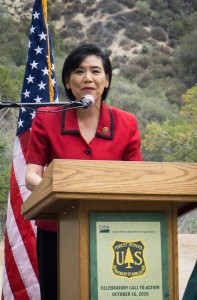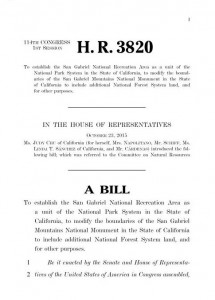Today, October 23, 2015, Congresswoman Judy Chu kep t a commitment made at the San Gabriel Mountains National Monument One Year Anniversary celebration last week, and revealed to CORBA and MWBA in a meeting a few weeks prior to that. She has introduced House Bill 3820, The San Gabriel Mountains Foothills and Rivers Protection Act.
t a commitment made at the San Gabriel Mountains National Monument One Year Anniversary celebration last week, and revealed to CORBA and MWBA in a meeting a few weeks prior to that. She has introduced House Bill 3820, The San Gabriel Mountains Foothills and Rivers Protection Act.
The act establishes a new unit of the National Park Service. At our preliminary reading of the Act, it appears to be largely consistent with Alternative D of the San Gabriel Watershed and Mountains Special Resource Study (SGWMSRS), which we supported, albeit with some concerns and caveats.
This act goes to great lengths in protecting existing water, property, utility and infrastructure rights, and expressly prohibits the use of Eminent Domain to acquire property. It establishes an Advisory Committee under the Federal Advisory Committee Act (FACA), which includes water agencies, infrastructure, local governments, conservancies, environmentalists, recreation including OHV, and other stakeholders. It doesn’t, however, specifically mention bicycles. It also establishes a partnership committee to support the NRA.
The bill authorizes the National Park Service to establish the San Gabriel National Recreation Area as a new unit of the NPS. It allows them to enter into partnerships and collaborate with existing and willing land managers with the proposed boundary. This includes the Army Corps of Engineers who own and operate much of the flood control infrastructure along the river. It permits and encourages collaborations and partnerships to be leveraged to improve habitat, recreation, resource protection, water quality, infrastructure or any of the purposes for which the NRA will be established ( as specified in Section 102(A) of the bill). The NPS can only acquire land from willing sellers and enter into partnership with willing entities, agencies, and nonprofits. Despite claims to the contrary, this is not a “land grab.”
 The bill gives the National Park Service three years to develop a management plan and a visitor services plan, in conjunction with the Advisory Committee (and as required by NEPA, the public). There are however two words that appear highly subjective. In Section 108 (a)(3)(B) In the development of a Visitor Services Plan, the Secretary Shall consider the demand for various types of recreation (including hiking, picnicking, horseback riding, and the use of motorized and mechanized vehicles) where permissible and appropriate; [Emphasis added]. The word “appropriate” in this context is too subjective, without any reference to who makes the determination for appropriateness, and by what criteria. We know there are many who deem bicycles inappropriate anywhere, and we would hope that any determination of appropriateness of bicycles or any other form of recreation be transparent and include public involvement beyond the Advisory Committee and Partnership.
The bill gives the National Park Service three years to develop a management plan and a visitor services plan, in conjunction with the Advisory Committee (and as required by NEPA, the public). There are however two words that appear highly subjective. In Section 108 (a)(3)(B) In the development of a Visitor Services Plan, the Secretary Shall consider the demand for various types of recreation (including hiking, picnicking, horseback riding, and the use of motorized and mechanized vehicles) where permissible and appropriate; [Emphasis added]. The word “appropriate” in this context is too subjective, without any reference to who makes the determination for appropriateness, and by what criteria. We know there are many who deem bicycles inappropriate anywhere, and we would hope that any determination of appropriateness of bicycles or any other form of recreation be transparent and include public involvement beyond the Advisory Committee and Partnership.
Also required is the establishment of the San Gabriel National Recreation Partnership, consisting of the many land managers, utility managers, and local governments within the boundary. The partnership includes “One designee of San Gabriel Mountains National Monument Community.” We wonder if this is a referral to the Community Collaborative, on which CORBA President Steve Messer serves to represent bicycle recreation interests.
That original SGWMSR Study and the Alternative D supported by CORBA included most of the San Gabriel Watershed within the Angeles National Forest. This study concluded in in 2011, and was the precursor to our National Monument. In early 2014, Chu introduced legislation to establish a National Recreation Area in accordance with the study, but it was clear it was not going to make it out of committee in the congressional climate at that time. This urged her and other advocates to seek alternative protection for the San Gabriel Watershed, ie. to have President Obama declare a San Gabriel Mountains National Monument (SGMNM), which included all of the San Gabriel Watershed, and then some.
One of our concerns with Alternative D of the SGWSRS was how it was going to be funded. At the time, in 2011, the Nation’s economy was in a much sorrier state than it is today, so the financial and administrative burdens a new NPS unit would create were, and still remain a concern. While we are doing better economically, we all know that our public land agencies are all dealing with reduced budgets and severe cutbacks over the past decades. As we commented in 2011, we would hope that funding be secured from additional sources that do not impact or reduce the budgets of other NPS or USFS units, including our local Santa Monica Mountains National Recreation Area and Angeles National Forest/San Gabriel Mountains National Monument.
Another concern we had with the SGWMSRS was that Forest Service land outside the San Gabriel Watershed Study area under Alternative D would receive reduced services and resources from the Forest Service. We didn’t want to see all the priorities going to the National Recreation Area. Much of the area left out of the National Monument was not in the original San Gabriel Watershed Special Resource Study, which some have speculated is a reason for the exclusion from the National Monument. With our SGMNM, we have the same concerns: that areas outside the Monument under Forest Service control would be the forgotten stepchild of the National Monument. While much attention is being placed on the National Monument, we are also seeing benefits to the rest of the Forest.
Chu’s legislation aims to correct the omission of those Forest Service lands from the SGMNM. Title 2 of HR3820 appears to expand the boundary of the existing SGMNM to include all of the Angeles National Forest south of the 14 and east of the 5. It makes no other claims and places no additional burdens on the Forest Service with respect to additional time to prepare a Management Plan. We are beginning to see the impacts of the additional funding the National Monument designation has brought to the Angeles National Forest. Thus far, we see it as good for the Forest. While we do have concerns that when and if the current bill is enacted, the Monument Management plan currently in development will need to be revised once again. Chu’s bill simply applies whatever existing National Monument management plan is in place or in development to the expanded Monument. While sounding simple in theory, the burden of changing boundaries and evaluating the additional cultural, historical, ecological and recreational resources within the expansion will take additional time.
The expansion of the existing National Monument in HR3820 already has much support within the community. Tim Brick from the Arroyo Seco Foundation has been especially vocal about his disappointment with the way the current National Monument boundaries were drawn, and that it happened without any public process or explanation of the reasoning. His feelings are widely echoed in the community, especially now that we are seeing additional funds being allocated to the Forest Service since the National Monument designation.
Our initial thoughts on the bill are positive but guarded; we need more time to digest the content of the bill and its long-term ramifications. Its intentions are in line with those of CORBA’s mission: enhancing recreation, and protecting the lands on which we recreate. If you have strong feelings about the bill please let us know as we formulate our official position.
Map of the proposed San Gabriel National Recreation Area and San Gabriel Mountains National Monument Expansion:
Complete text of HR3820




